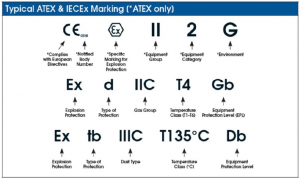Explosion Protection in Industrial Automation: Prioritizing Safety Over Profit
Explosion protection is not merely a compliance requirement—it’s a fundamental safety principle. As Chinese automation manufacturers expand into high-risk industries like petrochemicals, mining, and energy, understanding explosion protection standards becomes crucial for both global competitiveness and operational safety.
The Science Behind Industrial Explosions
An explosion requires three essential elements:
- Explosive Substance – Gases (hydrogen, methane), liquids (alcohol, gasoline), or dust (sugar, metal, flour)
- Oxidizer – Typically oxygen present in the air
- Ignition Source – Sparks, hot surfaces, static discharge, or chemical reactions
The fundamental principle of explosion prevention involves eliminating any one of these three factors.
Understanding Explosion-Proof Equipment Markings: “Ex ed IIC T6″
This common marking on explosion-proof equipment indicates:
- Ex: Compliance with explosion protection standards
- e: Increased safety design
- d: Flameproof enclosure
- IIC: Suitable for high-risk gases (hydrogen, acetylene)
- T6: Maximum surface temperature ≤85°C (safe for substances with low ignition points)
Primary Explosion Protection Methods
Flameproof Enclosure (Ex d)
Specially designed to contain internal explosions and prevent ignition of external hazardous atmospheres.
Intrinsic Safety (Ex i)
Limits electrical energy to levels below what’s needed to cause ignition, even during fault conditions. Requires isolation barriers to maintain safety throughout the system.
Hazardous Area Classification: Zones, Gas Groups & Temperature Ratings
Zone Classification (IEC Standards)
- Zone 0: Continuous presence of explosive atmosphere
- Zone 1: Likely presence during normal operations
- Zone 2: Rare or brief presence of explosive atmosphere
Gas Group Classification
- IIA: Low risk gases (propane)
- IIB: Medium risk gases (ethylene)
- IIC: High risk gases (acetylene, hydrogen)
Temperature Ratings
| T-Class | Maximum Surface Temperature |
|---|---|
| T1 | ≤450°C |
| T6 | ≤85°C |
Historical Accidents: Lessons in Safety
- BP Texas City (2005): 15 fatalities caused by ignition of hydrocarbon vapors
- Buncefield, UK (2005): Massive fuel-air explosion resulting from tank overfill
- Imperial Sugar, USA (2008): Dust explosion claiming 14 lives due to inadequate housekeeping
These tragedies underscore the critical importance of certified, zone-appropriate explosion protection systems.
Selecting Safe Automation Equipment: Key Considerations
When choosing automation solutions for hazardous environments, always verify:
- Does the equipment match your specific zone and gas group requirements?
- Is the temperature class appropriate for your application?
- Are all components part of a certified explosion-proof system?
Never compromise on explosion protection standards. Safety must be the driving force behind design decisions—because what’s at stake extends far beyond financial investment to human lives.
Post time: May-06-2025





